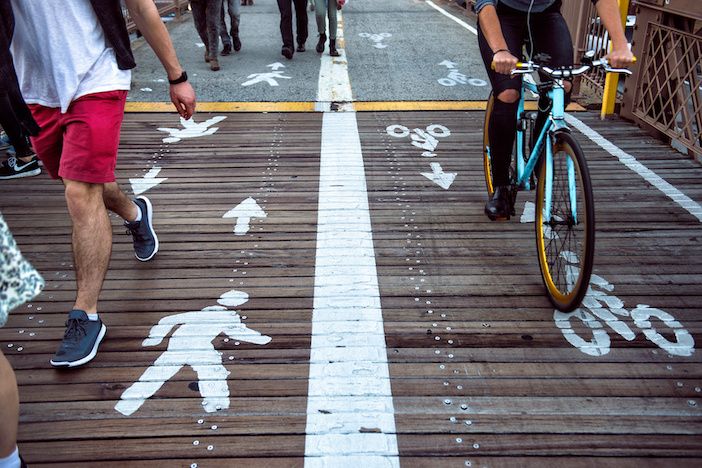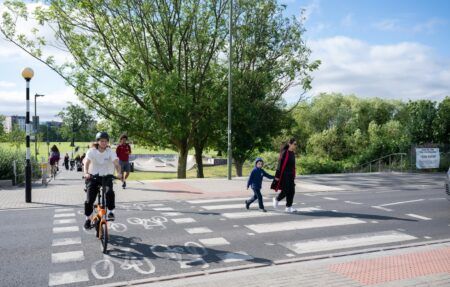London’s low traffic neighbourhoods (LTNs) benefit local streets, but new schemes could be made more effective and less controversial with good design, community engagement, and tailored support for those who are most impacted, according to a new report from think tank Centre for London.
The report, Street Shift: The Future of Low Traffic Neighbourhoods, reviewed the rollout of LTNs by London local authorities over recent years. It found that LTNs can benefit local streets by reducing car traffic, increasing walking and cycling, and making roads safer for all users. But the report argues that LTNs alone can’t address reliance on the private car because they do little to reduce the traffic on main roads and, in some cases, there has been an increase in traffic outside of the LTNs.
The think tank sees LTNs as part of the solution to reducing private car use in the UK capital, but argues that they should be introduced alongside complementary measures including promoting cycle training, introducing new public transport options, and establishing a denser network of bike and scooter hire and car clubs.

Centre for London is calling on the UK government to give new powers to the Mayor of London and the boroughs to help achieve the behavioural changes that reduce the use of private cars. With these powers, funds can be raised for the delivery of complementary changes such as protected cycle lanes, financial incentives such as mobility credits, and investment to improve public transport.
Reviewing schemes that were introduced during and after the Covid-19 pandemic, the report makes a number of recommendations to improve the design, experience and outcomes of LTNs.
- Councils and Transport for London need to take action to minimise traffic displacement, including across borough boundaries. Reviewing monitoring data from nine schemes, Centre for London found there were big reductions in car traffic inside the low traffic neighbourhoods but the picture is more mixed for car traffic on boundary roads. The report highlights that these schemes were implemented as emergency measures and couldn’t follow usual standards in terms of consultation and design. It recommends that traffic modelling should be done before implementation of the next generation of schemes and must include monitoring changes outside the LTNs early on.
- LTNs significantly increase cycling levels but more could be done to encourage take up. Reviewing monitoring data from seven schemes, the report found that there were substantial increases in cycling within the low traffic neighbourhoods. The report argues that more could be done to encourage walking and cycling, from reallocating road space and redesigning junctions, to widening pavements and promoting cycle training.
- More needs to be done to make sure road users are aware of changes to road access, including emergency vehicles, delivery vehicles and blue badge holders. The report calls for the introduction of a national open database of planned changes to road access rules and early work to ensure that new measures are mapped onto online source data for satellite navigation systems. The report recommends that, where necessary, local authorities switch from physical to camera-enforced filters that allow emergency services access.
- Funding should be made available for consultation and communication. The report recommends that the government should make funding available to local authorities and Transport for London so that they can engage residents meaningfully over LTNs and support those who are most impacted by their introduction.
- LTNs should be introduced alongside other complementary measures. The report recommends that London should develop a denser network of bike and scooter hire, car clubs, and new public transport options. The Mayor of London should also consider changing current road pricing schemes like the Congestion Charge and ULEZ to distance-based road user charging, accompanied by new charges and controls on workplace and residential parking.
- The report also suggests developing tailored support to encourage people to trade in their cars with the help of scrappage schemes and vouchers that could include public transport, bike, scooter (for hire or purchase), or car club memberships.

“We’re calling on the government to give the Mayor of London and the boroughs new powers to raise funds themselves, for the delivery of sustainable travel measures such as low-traffic neighbourhoods,” says Nicolas Bosetti, head of Data and Insight at Centre for London.
“By offering a package of measures and by consulting local people and street users in advance, local authorities can make low traffic neighbourhoods more effective, and less controversial.”
The research was funded by Foundation for Integrated Transport, and sponsored by Enterprise Holdings, London Borough of Enfield and London Borough of Lewisham.
Image: Adobe Stock.





